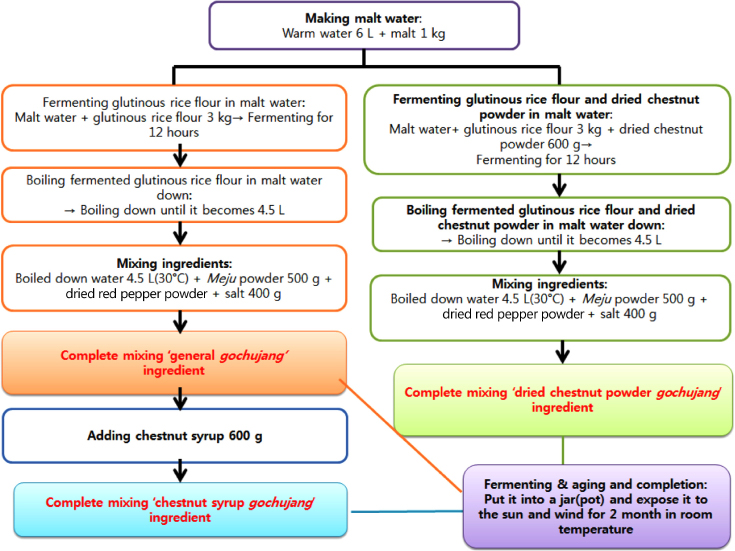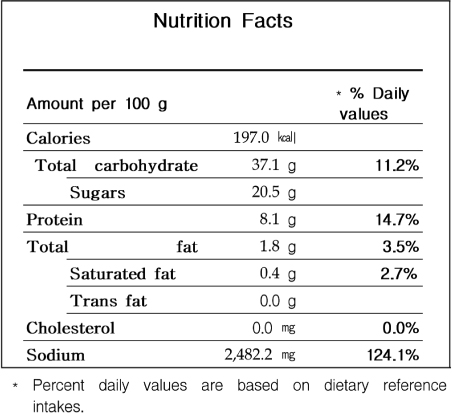J Nutr Health.
2016 Oct;49(5):395-399. 10.4163/jnh.2016.49.5.395.
Study on nutritional property and use potential of Gochujang using Gongju chestnuts
- Affiliations
-
- 1Department of Technology and Home Economics Education, Kongju National University, Gongju 32588, Korea. shkim@kongju.ac.kr
- KMID: 2357141
- DOI: http://doi.org/10.4163/jnh.2016.49.5.395
Abstract
- PURPOSE
Gongju is a famous area for chestnuts, which contain various nutrients and phytochemicals. This study aimed to develop gochujang items using Gongju chestnuts and analyze nutritional properties for the best item by sensory evaluation in order to increase marketability of chestnut processed foods.
METHODS
Gochujang was prepared, and nutrient contents of gochujang were analyzed according to the methods of the food fair by Korea Food Research Institute. Three kinds of gochujang, including general (control)-, dried chestnut powder-, and chestnut syrup- were prepared. Sensory evaluation was performed on three kinds of gochujang by 45 adults, including males and females (20's~60's years of age).
RESULTS
Chestnut syrup-gochujang was evaluated as significantly higher than general- or dried chestnut powder-gochujang by sensory evaluation. Thus, nutrition facts were produced for chestnut syrup gochujang. Nutrient contents per 100 g of chestnut syrup gochujang and traditional gochujang in the literature were similar in terms of total carbohydrates and fat, whereas protein content was higher and sodium content was lower in chestnut syrup gochujang than in traditional gochujang in the literature.
CONCLUSIONS
The results imply that chestnut syrup gochujang has nutritional benefits such as higher content of protein and lower content of sodium than traditional gochujang in the literature, in addition with its good taste. Therefore, chestnut syrup gochujang may have high usage potential. There is a need to improve the quality and storage of chestnut syrup gochujang through future study.
Keyword
MeSH Terms
Figure
Reference
-
1. Yoo JH. Fermentation technology. Seoul: Hyoilmunhwasa;2008.2. Jeong DH. Great dictionary of traditional fermented soybean sauce. Seoul: Hongikjae;2013.3. Korean Nutrition Society. Food values. Seoul: Korean Nutrition Society;2009.4. Son KH. Cookery science of Korean foods. Seoul: Gyomoonsa;2001.5. Kim HY, Park ML, Kim DS, Choi SK. Quality characteristics of modified Kochujang made with tofu powder instead of meju powder. Korean J Culinary Res. 2012; 18(5):293–304.6. Koh JY, Kim KB, Choi SK. Quality characteristics of gochujang containing various amounts of persimmon syrup. Korean J Culinary Res. 2013; 19(1):139–150.7. Lee HS, Kim EJ, Kim SH. Chestnut extract induces apoptosis in AGS human gastric cancer cells. Nutr Res Pract. 2011; 5(3):185–191.
Article8. Korea Food Industry Association. Food fair. Seoul: Moonyoungsa;2008.9. Ministry of Food and Drug Safety (KR). Standard criteria on foods and others: 2013-132 [Internet]. Seoul: Ministry of Food and Drug Safety;2013. 04. 05. cited 2013 Nov 20. Available from: http://www.law.go.kr/admRulSideInfoP.do?admRulSeq=2000000024158&langType=Ko&chrClsCd=010202&joNo=0002&joBrNo=00&docCls=jo&joChgYn=N&urlMode=admRulScJoRltInfoR.
- Full Text Links
- Actions
-
Cited
- CITED
-
- Close
- Share
- Similar articles
-
- A Korean Model of Dementia Management
- Reliability and Validity of the Korean Version of Beck Depression Inventory-II via the Internet : Results from a University Student Sample
- Factor Analysis of the Young's Internet Addiction Test : In Korean College Students Group
- Nutritional Supplementation in Stroke Rehabilitation: A Narrative Review
- Attitudes of Medical Staff and Factors Related to Nutritional Support for Patient Care in a University Hospital



